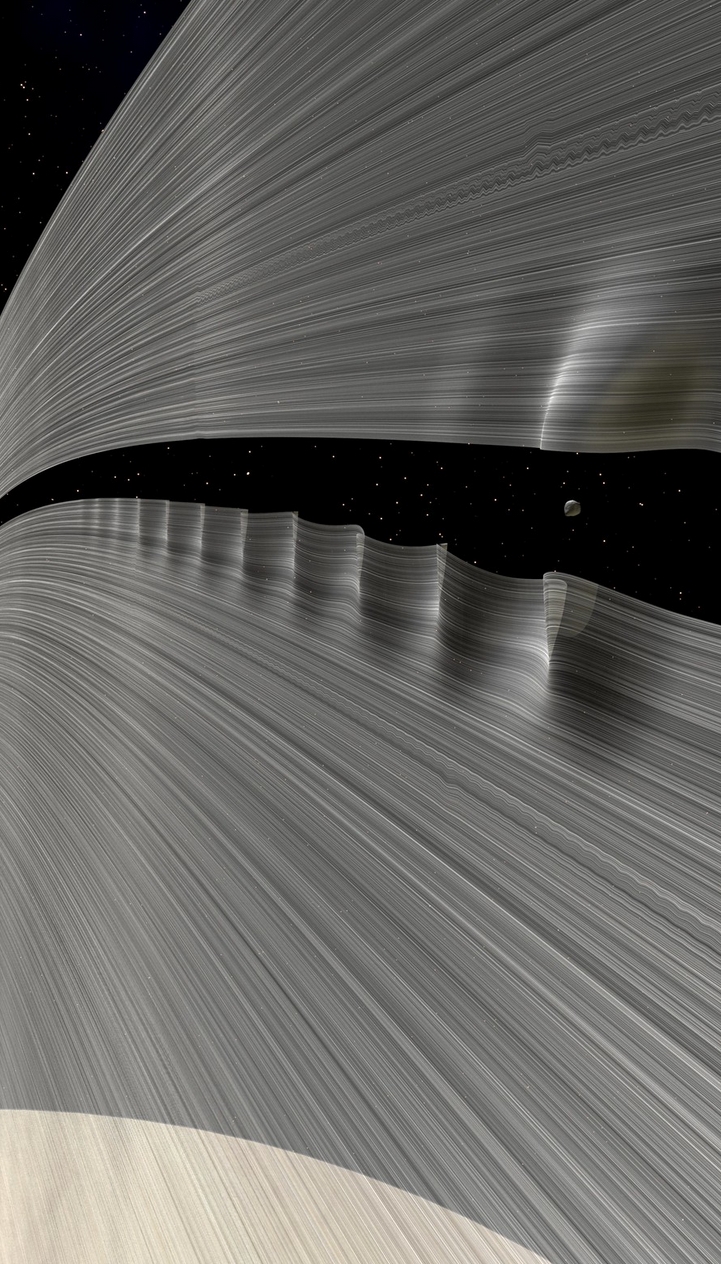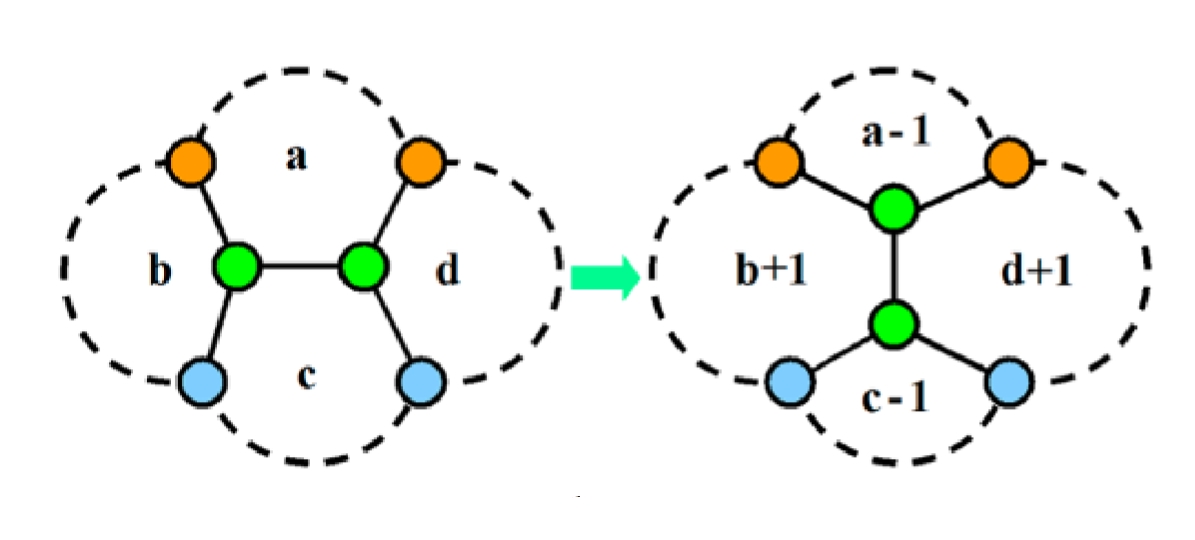
Did you see this? It's an artist's conception of how gravity from the tiny moon Daphnis creates ripples in Saturn's rings — created by Kevin Gill of NASA.
This image has been pretty popular on social media — but people often don't come out and say from the start that it's not a photo. The actual photos are less glamorous but... hey, they're real! And the ripples look different in the photos. Let's take a look.
This 2005 photo, taken by the Cassini probe, was the first time anyone actually saw Saturn's moon Daphnis! It's only 8 kilometers across. This gap in Saturn's A ring was first discovered by Voyager, and it was named the Keeler Gap. It's 35 kilometers wide. I guess this gap in the A ring let people guess the existence of a moon, and later the ripples in the let people guess where the moon must be. I don't really know the history here.
There's a larger gap in the A ring called the Encke Gap, created by a larger moon called Pan, which you can see clearly here.
To the left you see the smaller Keeler Gap. If you look very closely you can see the ripples near the Keeler gap... and if you look very closely you can see Daphnis!
Pan is closer to Saturn, so it orbits faster, and it overtakes Daphnis every 19 days.
Now here is a really great actual photo of Daphnis and the ripples it creates in Saturn's rings! It was taken by the Cassini probe and released in February 2017. It was taken in visible light using Cassini’s narrow-angle camera. Cassini was 28,000 kilometers away from Daphnis, and the image scale is 168 meters per pixel.
Above is a nice photo of Daphnis and the Keeler gap in real color. It was taken by Cassini on July 5, 2010 — taken in red, green, and blue and then recombined.
And here's an excellent image of Daphnis taken by the Cassini spacecraft on one of its ring-grazing passes on January 16, 2017 — the closest to Daphnis it's gotten so far, I believe!
NASA says:
Material on the inner edge of the gap orbits faster than the moon, so the waves there lead the moon in its orbit. Material on the outer edge moves slower than the moon, so waves there trail the moon. The waves Daphnis causes cast shadows on Saturn during its equinox when the sun is in line with the plane of the rings.

Buckminsterfullerene is a molecule shaped like a soccer ball, made of 60 carbon atoms. If one of the bonds between two hexagons rotates, we get the weird mutant version of this molecule shown above.
This is an example of a Stone-Wales transformation: a 90° rotation in a so-called 'π bond’ between carbon atoms. Here's how it works in graphene:

Graphene is a sheet of carbon molecules arranged in hexagons. When they undergo a Stone–Wales transformation, we get a Stone–Wales defect with two pentagons and two heptagons, like this:

This picture is from Jacopo Bertolotti, based on a picture by Torbjörn Björkman which appeared in this paper:
You'll notice that in buckminsterfullerne the Stone–Wales transformation turned 2 hexagons and 2 pentagons into two pentagons and 2 hexagons, while in graphene it turned 4 hexagons into 2 pentagons and 2 heptagons. The general pattern is this:

I think it's cool how a simple topological transformation akin to the Pachner moves shows up in chemistry!
I got the above image from here:
There should be a nice theory of topological transformations like Stone--Wales transformations or Pachner moves occurring randomly, following the laws of statistical mechanics. I guess the study of matrix models moves in this direction, but there's no Arrhenius equation there, I don't think!
May 24, 2025

One of the things I love about Hong Kong is the use of bamboo rather than metal scaffolding for the construction of buildings. You see elaborate bamboo scaffolds towering into the sky.
Here's a story about this ancient craft, what's happening to it today, and one of the few women who practices it:
Lots of great pictures, taken by Lam Yik Fei!

As a truckload of bamboo poles pulled into a narrow street, Daisy Pak stubbed out a cigarette, pulled a safety harness over her paint-streaked leggings and began blasting Prince from a Bluetooth speaker.After maneuvering a loaded cart into an elevator, she opened a tiny window on the ninth floor and ducked out onto a narrow pipe, a bunch of zip ties sashaying behind her back like a bushy tail. She called for mid-length bamboo poles that she tied into a latticework clinging to the outside of the building.
Ms. Pak, 31, is one of the few female bamboo scaffolding workers in Hong Kong, using an ancient Chinese practice that is synonymous with the city even as its use has faded elsewhere in China. She turned to the industry for a fresh start in 2021, after a hardscrabble upbringing and falling into drug addiction and debt. There was a demand for skilled construction workers, it paid relatively well, and she had a passion for the time-honored craft. "It’s so special, to build something completely all out of bamboo," she said.
Traditionally, workers learn their craft by shadowing one master with knowledge passed down through generations. But Ms Pak learned any way she could, working with different bosses to broaden her skills and techniques, and overcoming taunts about her ability as a novice and her 5-foot-1 stature. While dismantling a scaffold, a colleague once tossed her poles to catch instead of passing them downward. Contractors have tried to pay her less than she was promised. Her arms and legs were constantly bruised, but she carried on.
"I was born with the will to prove people wrong, to do things that they say cannot be done," she said.
[....]
The city is one of the last bastions of an art — and later industry — that was first depicted in scroll paintings from the Han dynasty around 2,000 years ago, and it has thrived in bamboo-rich regions in China. But in the past two decades, the rest of China pivoted toward metal amid an overproduction of steel.
Lattices of bamboo poles bound together by intricate knots regularly rise across the city to build and renovate apartment blocks and commercial skyscrapers that can be dozens of stories high.
Advocates of the material, including Ms. Pak, say it is lighter and cheaper than metal to transport and carry in Hong Kong’s tight urban spaces. Builders particularly favor the material when erecting platforms that support workers who patch up building exteriors and replace old pipes and window sills.